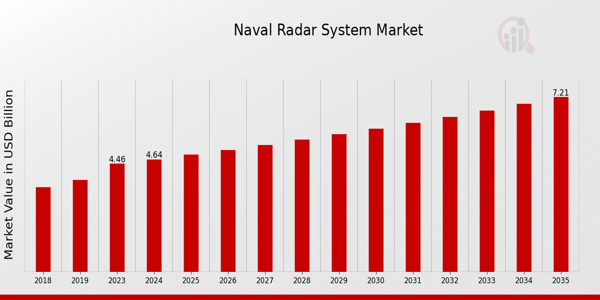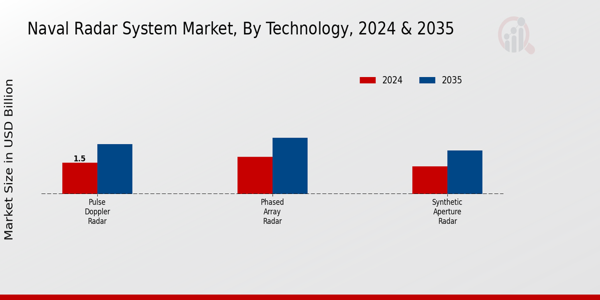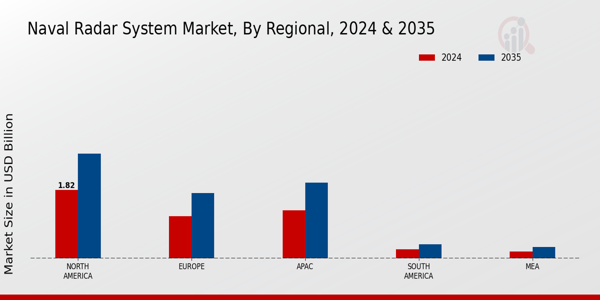Global Naval Radar System Market Overview
Naval Radar System Market Size was estimated at 4.46 (USD Billion) in 2023.The Naval Radar System Market is expected to grow from 4.64(USD Billion) in 2024 to 7.2 (USD Billion) by 2035. The Naval Radar System Market CAGR (growth rate) is expected to be around 4.08% during the forecast period (2025 - 2035).
Key Naval Radar System Market Trends Highlighted
The growing demand for sophisticated surveillance systems and the continuous upgrading of naval forces worldwide are two major factors propelling the naval radar system market. Investing in advanced radar technology becomes crucial as countries place a higher priority on marine safety and national security.
Additionally, naval forces have been forced to implement more dependable radar systems that improve situational awareness and operational capabilities due to the development of asymmetric warfare and threats like piracy.
The market's expansion is being shaped by the need for precise, real-time data to guide strategic decision-making. This sector has a lot of untapped potential, especially for the advancement of cutting-edge technologies like machine learning and artificial intelligence.
Integrating these technologies into naval radar systems can improve threat detection and operational efficiency. Emerging markets are also opening up as countries look to enhance their naval capabilities in response to regional threats.
Collaborations between defense contractors and technology firms may lead to innovative solutions that address specific naval requirements, presenting further growth avenues. Recent trends indicate a shift toward smaller, more compact radar systems that can be easily integrated onto various platforms, including unmanned vessels.
The increasing focus on cyber resilience in naval operations is also forcing manufacturers to ensure their radar systems are secure from cyber threats. There is a noticeable push for dual-use capabilities, allowing both military and civilian applications, thus broadening the market.
The emphasis on sustainability in defense technology is leading to advancements that reduce the environmental impact of naval operations. As technology evolves, the naval radar market continues to adapt, responding to new challenges and changing defense strategies worldwide.

Source: Primary Research, Secondary Research, MRFR Database and Analyst Review
Naval Radar System Market Drivers
Increasing Naval Modernization Efforts
The Naval Radar System Market is driven significantly by the ongoing modernization of naval forces across various countries. As geopolitical tensions rise globally, many nations are investing heavily in updating and enhancing their fleet capabilities.
This includes integrating advanced technologies to maintain maritime security and combat effectiveness. Modern naval radar systems offer superior surveillance, target acquisition, and threat detection capabilities, making them essential for contemporary naval operations.
These upgraded systems not only improve the operational readiness of naval fleets but also ensure that they can effectively respond to emerging threats. The increased focus on defense spending, particularly from nations with expansive coastlines or strategic maritime interests, is pushing the adoption of sophisticated radar technologies.
Furthermore, advancements in radar technologies, such as phased array and solid-state systems, have made it possible to enhance range, accuracy, and reliability. As countries continue to prioritize their maritime defense capabilities, the Naval Radar System Market stands to benefit immensely from these modernization initiatives, anticipating sustained growth in investments throughout the next decade.
Technological Advancements in Radar Systems
Rapid technological advancements are playing a crucial role in the expansion of the Naval Radar System Market. Innovations such as artificial intelligence, machine learning, and advanced signal processing are enhancing the capability of naval radar systems significantly.
These technologies enable improved target discrimination, automated tracking, and reduced false alarm rates, thereby improving situational awareness for naval operators. As the military sector continues to integrate these tech advancements, the demand for next-generation radar systems increases, further driving market growth.
Growing Maritime Security Concerns
The escalation of maritime security challenges, including piracy, smuggling, and territorial disputes, is a significant driver for the Naval Radar System Market. The necessity to secure vital shipping lanes and strategic waterways has compelled nations to enhance their naval surveillance capabilities.
As threats from non-state actors and potential maritime conflicts rise, there is a growing emphasis on investing in advanced radar systems that can provide real-time data and operational insights. This trend underscores the essential role of radar technology in safeguarding national interests and maritime assets.
Naval Radar System Market Segment Insights
Naval Radar System Market Technology Insights
The Naval Radar System Market was poised for significant growth, with the Technology segment showcasing considerable advancements and diversification. The growth was driven by increasing defense budgets, the need for enhanced situational awareness, and the emphasis on national security.
Within the Technology segment, Pulse Doppler Radar emerged as a major player, valued at 1.5 USD Billion in 2024 and expected to grow to 2.4 USD Billion by 2035. This technology was significant for its unparalleled ability to provide comprehensive tracking and accuracy in high-speed scenarios, making it indispensable for modern naval fleets navigating complex environments.
In addition, Phased Array Radar, valued at 1.8 USD Billion in 2024, is anticipated to grow to 2.7 USD Billion by 2035, rendering it another critical component of the Naval Radar System Market. This technology exceled in its agility and flexibility, allowing for rapid scanning and target acquisition, thereby reinforcing its dominance in naval operations.
Synthetic Aperture Radar also played a vital role, with a current market valuation of 1.34 USD Billion and an expected increase to 2.09 USD Billion by 2035. Recognized for its ability to create high-resolution images irrespective of weather conditions, this technology significantly enhances reconnaissance and surveillance capabilities.
Overall, the Naval Radar System Market segmentation highlighted the importance of these radar technologies, which were integral to the advancement of naval capabilities and operational effectiveness, as reflected in the market data and statistics.
The ongoing modernization of naval fleets and the increasing frequency of maritime operations also drove demand for these technologies, presenting ample opportunities for growth within the market.

Source: Primary Research, Secondary Research, MRFR Database and Analyst Review
Naval Radar System Market Application Insights
The Naval Radar System Market, particularly within the Application segment, has shown significant growth. This growth reflects a robust market presence driven by the increasing need for advanced naval capabilities and enhanced maritime security.
Within this segment, Surveillance applications play a crucial role in providing comprehensive situational awareness to naval forces, enhancing their operational readiness. Navigation systems are equally important, ensuring safe and efficient movement of ships, while Search and Rescue capabilities are critical for maritime safety, especially in high-risk scenarios.
Target Tracking applications dominate a substantial part of the market, supporting military precision and strategic advantages. These segments collectively contribute to the Naval Radar System Market revenue, reinforcing the industry's focus on technological advancements and the demand for more sophisticated radar systems.
The market experiences trends fueled by technological innovations and defense spending, indicating ample opportunities for growth and the necessity of addressing challenges like budget constraints and technological integration. All these insights highlight the importance of each application in strengthening naval capabilities and operational effectiveness.
Naval Radar System Market End Use Insights
The Naval Radar System Market is characterized by its diverse End Use applications, encompassing Naval Forces, Coast Guard, and Commercial Maritime sectors. The Naval Forces sector remains pivotal, utilizing radar systems for enhanced surveillance and targeting capabilities.
Meanwhile, the Coast Guard segment plays a significant role in maritime law enforcement and search and rescue operations, making it crucial for national security. The Commercial Maritime segment, although less discussed, contributes considerably to the market as shipping companies integrate advanced radar systems to ensure safe navigation and collision avoidance.
The interplay between these applications underscores the strategic importance of radar technology in sustaining maritime operations. With ongoing developments and increasing investments in naval infrastructure, the Naval Radar System Market relies heavily on growth and funding across these sectors, effectively shaping its dynamics and future trajectory.
Naval Radar System Market Frequency Band Insights
The segment comprises various frequency bands, including X Band, S Band, C Band, and L Band, each playing a unique role in maritime operations. The X Band is known for its high resolution and is primarily utilized for target detection and tracking, making it critical for various naval applications.
The S-Band, while less resolution-intensive, offers significant advantages in long-range detection and is popular for weather and air traffic monitoring. C Band strikes a balance between range and resolution, hence its growing use in both military and civilian maritime systems.
Meanwhile, L Band, with its ability to penetrate adverse weather conditions, is crucial for persistent surveillance. As a whole, the Frequency Band segment contributes significantly to the overall market growth, driven by advancements in radar technology and the increasing need for maritime security, positioning it as a central focus within the Naval Radar System Market statistics.
Naval Radar System Market Regional Insights
North America dominated the market, holding a significant valuation of 1.82 USD Billion in 2024, which is expected to grow to 2.78 USD Billion by 2035. This dominant position was driven by increased defense spending and advanced technological infrastructure in this region.
Following closely, Europe exhibited an important role in the market with a valuation of 1.12 USD Billion in 2024 and expected growth to 1.73 USD Billion in 2035, reflecting ongoing military enhancements and collaborations.
The APAC region revealed significant growth potential, valued at 1.28 USD Billion in 2024 and anticipated to reach 2.01 USD Billion by 2035, driven by rising maritime threats and modernization of naval fleets.
South America and MEA contributed smaller yet notable figures, with valuations of 0.24 USD Billion and 0.18 USD Billion in 2024, respectively, and projected increases to 0.38 USD Billion and 0.3 USD Billion by 2035, illustrating a growing interest in naval capabilities.
These diverse market dynamics were crucial for understanding the Naval Radar System Market revenue and segmentation strategies, providing insights into trends and challenges within the industry.

Source: Primary Research, Secondary Research, MRFR Database and Analyst Review
Naval Radar System Market Key Players and Competitive Insights
The Naval Radar System Market represents a significant segment within the broader defense industry, characterized by a rich array of technological advancements and a diverse set of players vying for market share.
The competitive landscape is shaped by the increasing demand for enhanced surveillance, tracking, and defense capabilities among naval forces globally. As nations expand their naval fleets to address evolving security threats and maintain maritime supremacy, the role of innovative radar systems becomes ever more critical.
This demand has driven competition among industry leaders to develop cutting-edge solutions that integrate advanced features such as multi-function capabilities, improved resolution, and superior target discrimination, all of which are essential for modern naval operations.
With emergent technologies like artificial intelligence and machine learning influencing radar system functionalities, the competitive insights within this market illustrate a landscape that is both dynamic and progressive.
Lockheed Martin stands as a prominent player in the Naval Radar System Market, showcasing its commitment to delivering state-of-the-art radar technologies specifically tailored for naval applications. The company benefits from a strong reputation for quality and reliability in defense and aerospace sectors, enabling it to maintain a significant presence in global naval operations.
Lockheed Martin’s strengths lie in its comprehensive portfolio of advanced radar systems that offer unmatched performance in hostile environments. Its focus on innovation allows for the integration of cutting-edge technologies, enhancing situational awareness and operational effectiveness for naval forces.
The company's collaborative partnerships with military agencies and investment in research and development further bolster its competitive edge, making it a leader in providing sophisticated solutions that meet the strategic needs of contemporary maritime security.
BAE Systems also holds a noteworthy position within the Naval Radar System Market, leveraging its extensive experience and expertise to offer advanced naval radar solutions. BAE Systems prides itself on its technological prowess and commitment to evolving naval capabilities in the face of emerging threats.
Its portfolio includes cutting-edge radar systems that are designed to provide comprehensive surveillance and threat detection, essential for safeguarding maritime interests. The company’s focus on integration and adaptability ensures that its radar solutions can be seamlessly incorporated into existing naval platforms and operational frameworks.
With a strong emphasis on maintaining the highest standards of performance and reliability, BAE Systems continues to innovate within the radar domain, addressing the specific requirements of naval forces and enhancing their ability to respond to complex maritime challenges effectively.
Key Companies in the Naval Radar System Market Include:
- Lockheed Martin
- BAE Systems
- Elbit Systems
- General Dynamics
- Saab AB
- Hindustan Aeronautics Limited
- Thales Group
- Hewlett Packard Enterprise
- Raytheon Technologies
- Aselsan
- Telespazio
- Kongsberg Gruppen
- Rohde and Schwarz
- Leonardo S.p.A.
- Northrop Grumman
Naval Radar System Market Developments
Recent developments in the Naval Radar System Market have been significant, with a focus on technological advancements and strategic expansions. Companies such as Lockheed Martin and Raytheon Technologies have introduced cutting-edge radar technologies aimed at enhancing maritime surveillance capabilities.
Meanwhile, BAE Systems and Elbit Systems have reported increased investments in research and development to improve the accuracy and reliability of naval radars. Current affairs also highlight the competitive landscape, with firms like Northrop Grumman and Thales Group expanding their global footprint through partnerships and defense contracts with various nations.
In terms of mergers and acquisitions, there have been notable activities as companies seek to consolidate their market position. For instance, reports indicate that Saab AB is pursuing strategic alliances to bolster its product offerings within naval radar systems.
Additionally, Hindustan Aeronautics Limited has collaborated with Kongsberg Gruppen to enhance indigenous capabilities in maritime radar solutions, which is expected to positively impact the market’s growth trajectory.
The increasing geopolitical tensions and defense spending globally continue to fuel demand and innovation within this sector. As a result, companies are witnessing a rise in their market valuation, further contributing to the industry's expansion and technological advancement.
Naval Radar System Market Segmentation Insights
- Naval Radar System Market Technology Outlook
- Pulse Doppler Radar
- Phased Array Radar
- Synthetic Aperture Radar
- Naval Radar System Market Application Outlook
- Surveillance
- Navigation
- Search and Rescue
- Target Tracking
- Naval Radar System Market End Use Outlook
- Naval Forces
- Coast Guard
- Commercial Maritime
- Naval Radar System Market Frequency Band Outlook
- X Band
- S-Band
- C Band
- L Band
- Naval Radar System Market Regional Outlook
- North America
- Europe
- South America
- Asia Pacific
- Middle East and Africa
| Attribute/Metric Source: |
Details |
| MARKET SIZE 2023 |
4.46(USD Billion) |
| MARKET SIZE 2024 |
4.64(USD Billion) |
| MARKET SIZE 2035 |
7.2(USD Billion) |
| COMPOUND ANNUAL GROWTH RATE (CAGR) |
4.08% (2025 - 2035) |
| REPORT COVERAGE |
Revenue Forecast, Competitive Landscape, Growth Factors, and Trends |
| BASE YEAR |
2024 |
| MARKET FORECAST PERIOD |
2025 - 2035 |
| HISTORICAL DATA |
2019 - 2024 |
| MARKET FORECAST UNITS |
USD Billion |
| KEY COMPANIES PROFILED |
Lockheed Martin, BAE Systems, Elbit Systems, General Dynamics, Saab AB, Hindustan Aeronautics Limited, Thales Group, Hewlett Packard Enterprise, Raytheon Technologies, Aselsan, Telespazio, Kongsberg Gruppen, Rohde and Schwarz, Leonardo S.p.A., Northrop Grumman |
| SEGMENTS COVERED |
Technology, Application, End Use, Frequency Band, Regional |
| KEY MARKET OPPORTUNITIES |
Increased defense spending globally, Adoption of advanced radar technologies, Demand for upgraded naval capabilities, Rising geopolitical tensions and threats, Integration of AI in radar systems |
| KEY MARKET DYNAMICS |
Technological advancements, Military modernization programs, Growing maritime security threats, Increasing defense budgets, Demand for advanced surveillance systems |
| COUNTRIES COVERED |
North America, Europe, APAC, South America, MEA |
Frequently Asked Questions (FAQ) :
The projected market size of the Global Naval Radar System Market in 2024 is 4.64 USD Billion.
The market value of the Global Naval Radar System Market is expected to reach 7.2 USD Billion by 2035.
The expected CAGR for the Global Naval Radar System Market from 2025 to 2035 is 4.08%.
North America is expected to hold the largest market share in the Global Naval Radar System Market in 2024, valued at 1.82 USD Billion.
The Phased Array Radar technology segment is valued at 1.8 USD Billion in 2024 and is expected to grow to 2.7 USD Billion by 2035.
Key players in the Global Naval Radar System Market include Lockheed Martin, BAE Systems, Elbit Systems, and Raytheon Technologies.
The Synthetic Aperture Radar technology segment is valued at 1.34 USD Billion in 2024.
The expected market size for the APAC region by 2035 is 2.01 USD Billion.
Future growth opportunities in the Global Naval Radar System Market include advancements in technology and increasing military spending across nations.
The market value of the North America region is expected to reach 2.78 USD Billion by 2035.

















